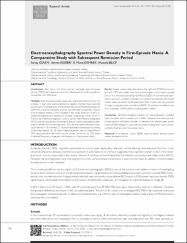| dc.contributor.author | Güven, Sertaç | |
| dc.contributor.author | Kesebir, Sermin | |
| dc.contributor.author | Demirer, Rüştü Murat | |
| dc.contributor.author | Bilici, Mustafa | |
| dc.date.accessioned | 2019-01-05T19:45:48Z | |
| dc.date.available | 2019-01-05T19:45:48Z | |
| dc.date.issued | 2013-12-11 | |
| dc.identifier.issn | 1300-0667 | |
| dc.identifier.uri | http://hdl.handle.net/11363/804 | |
| dc.description.abstract | Introduction: Our aim in this study was to investigate spectral power density (PSD) in first-episode mania and subsequent remission period and to evaluate their difference.
Methods: Sixty-nine consecutive cases referring to our hospital within the previous 1 year, who were evaluated as bipolar disorder manic episode according to The Diagnostic and Statistical Manual of Mental Disorders-IV (DSM-IV) at the first episode and had the informed consent form signed by first degree relatives, were included in this study. Exclusion criteria included having previous depressive episode, using drugs which could influence electroencephalographic activity before electroencephalography (EEG), and having previous neurological disease, particularly epilepsy, head trauma, and/or loss of consciousness. EEG records were obtained using a digital device in 16 channels; 23 surface electrodes were placed according to the International 10-20 system. Spectral power density (db mu V/Hz) of EEG signal provided information on the power carried out by EEG waves in defined frequancy range per unit frequency in the present study.
Results: A peak power value detected on the right with FP2P4 and on the left with F7T3 electrodes were found to be higher in the manic episode than in the remission period (p=0.018 and 0.025). In the remission period, in cases with psychotic symptoms during the manic period, F4C4 peak power value was found to be lower than that in cases with no psychotic findings during the manic period (p=0.027). There was no relation was found between YMRS scores and peak power scores.
Conclusion: Electrophysiological corollary of mood episode is present from the onset of the disease, and it differs between the manic and remission periods of bipolar disorder. In the remission period, peak power values of PSD distinguish cases with psychotic findings from cases without psychotic findings when they were manic. | en_US |
| dc.language.iso | eng | en_US |
| dc.publisher | AVES, BUYUKDERE CAD 105-9, MECIDIYEKOY, SISLI, ISTANBUL 34096, TURKEY | en_US |
| dc.relation.isversionof | 10.5152/npa.2015.7180 | en_US |
| dc.rights | info:eu-repo/semantics/openAccess | en_US |
| dc.rights | Attribution-NonCommercial-NoDerivs 3.0 United States | * |
| dc.rights.uri | http://creativecommons.org/licenses/by-nc-nd/3.0/us/ | * |
| dc.subject | Research Subject Categories::MEDICINE::Psychiatry | en_US |
| dc.subject | Research Subject Categories::SOCIAL SCIENCES::Social sciences::Psychology::Cognitive science | en_US |
| dc.title | Electroencephalography Spectral Power Density in First-Episode Mania: A Comparative Study with Subsequent Remission Period | en_US |
| dc.type | article | en_US |
| dc.relation.ispartof | Nöro Psikiyatri Arsivi | en_US |
| dc.department | İstanbul Gelişim Üniversitesi | en_US |
| dc.identifier.volume | 52 | en_US |
| dc.identifier.issue | 2 | en_US |
| dc.identifier.startpage | 194 | en_US |
| dc.identifier.endpage | 197 | en_US |
| dc.relation.publicationcategory | Kategori Yok | en_US |



















